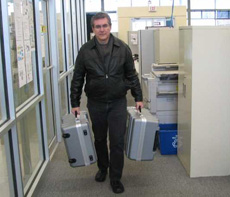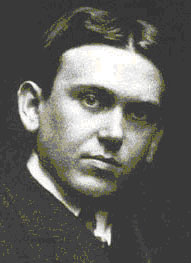|
Mon., January 22
2:30 p.m. Particle Astrophysics Seminar - Curia II
Speaker: F. Ferrer, Case Western Reserve University
Title: Indirect Detection of Light Neutralino Dark Matter
3:30 p.m. Director's Coffee Break - 2nd floor crossover
4:00 p.m. All Experimenters' Meeting - Curia II
Special Topics: Tevatron Separator Spark History;
MI-8 Collimator Study
Tue., January 23
11:00 a.m. Academic Lecture Series - 1 West
Speaker: E. Lunghi, Fermilab
Title: Course 3, Part 1 - Flavor Physics In and Beyond the SM;
CP Violation
11:00 a.m.
Computing Techniques Seminar -
FCC1
Speaker: D. Evans, Fermilab
Title: CMS ProdAgent and Production Infrastructure
2:30 p.m. Particle Astrophysics Seminar - (NOTE DATE) -
Curia II
Speaker: J. Weller, University College London
Title: Cosmology with Sunyaev-Zel'dovich Galaxy Cluster Counts
3:30 p.m. Director's Coffee Break - 2nd floor crossover
4:00 p.m. Accelerator Physics and Technology Seminar - 1 West
Speaker: Y. Sato, University of Indiana
Title: Electron-Proton Dynamics for Long Proton Bunches
in High Intensity Proton Rings
Click here for NALCAL,
a weekly calendar with links to additional information. |
|
Wednesday, January 24
Lunch
Grilled Salmon Fillet with Scallion Sauce
Winter Vegetable Medley
Mocha Profiteroles
Thursday, January 25
Dinner
Bacon Wrapped Sea Scallops
Ancho Fired Pork Tenderloin
Sweet Potato Stew
Rum Raisin Soufflé
Chez Leon Menu
Call x4598 to make your reservation. |
|
|
$50,000 suitcases fly to CERN

Starting in spring, John Conway will make four more trips across the Atlantic.
In all, he will hand-carry $4 million worth of CMS half-disks to build the
final version of the pixel tracker.
Last Wednesday, Fermilab physicists John Conway and Lalith Perera loaded a stash of expensive electronics into two boxy grey briefcases, crossed their fingers, and boarded a plane at O'Hare. They were bound for Switzerland with $50,000 worth of equipment in carry-on luggage. "Had we dropped the cases, I think I would have not returned to Fermilab but just kept on going," joked Conway.
The men's briefcases held silicon plates with over 100,000 delicate electrical connections arranged in half-disks, destined to rest near the heart of the CMS detector. The disks will form a prototype for the pixel detector; tracking particles flying out at the shallowest angles, and sorting debris from proton-proton collisions during the LHC's pilot run in November.
But before any of that could start, Fermilab's CMS group had to think of a way to get the four pounds of $50,000 electronics from Batavia to Geneva. The plan was to fly to Zurich and rent a car. But, of course, there was a snag: The complicated paperwork they had filled out only applied in Geneva--not Zurich. Instead of driving, they would need a last-minute connecting flight.
A security guard in Zurich agreed to watch the valuable cases at the airport while Conway and Perera took the rest of their bags through the normal screening process. On the secure side, they opened the cases, carefully removed the delicate inner-boxes, and sent them through the x-ray machine. "They peppered us with questions like 'What the heck are these things?' and 'What is the experiment at CERN for?'" said Conway, who will make the trek four more times--each time with much more elaborate, final versions of the disks for insertion after the LHC's pilot run. "These gigantic and complicated detectors are going to operate soon, as will the accelerator," said Conway, "and the really cool thing is that we really do not know what lies ahead, or what discoveries we will make."
--Siri Steiner
You can read more about Conway's recent adventure here.
|
Tevatron keeps humming
For the fourth week in a row the Tevatron has set a record. On Thursday evening at 6:00 p.m., the Tevatron achieved a peak luminosity record of 277.6 E30. Congratulations.
|
Scientific American,
January 19, 2007:
The Triangular Universe:
Instead of string theory, four-dimensional tetrahedrons
Imagine a landscape composed of microscopic triangular structures that constantly rearrange themselves into new patterns. Seen from afar, the landscape looks perfectly smooth, but up close it is a churning cauldron of strange geometries. This deceptively simple model is at the heart of a new theory called causal dynamical triangulation (CDT), which has emerged as a promising approach to solving the most vexing problem in physics--unifying the laws of gravity with those of quantum mechanics.
For more than 20 years, the leading contender in the quest for unification has been string theory, which posits that the fundamental particles and forces are actually minuscule strings of energy. But some scientists say this theory is misguided because it sets the strings against a fixed background; a better model, they argue, would generate not only particles and forces but also the spacetime they inhabit. In the 1980s and 1990s these researchers developed loop quantum gravity, which describes space as a network of tiny volumes only 10-33 centimeter across.
Read More
|
|
|
Age limits

"Old age ain't no place for sissies"
--Henry Louis Mencken (1880-1956)
As we age, it can be a challenge to monitor our changing abilities and redefine our work limits. Here are three areas where the impacts of advancing age can adversely affect your ability to work safely.
Balance - The body's balance organ becomes less sensitive and motions are less fluid. This can increase the risk of slips, trips and falls. Work processes should be modified to prevent slippery surfaces, elevation changes, awkward postures, and long reaches. Workers should engage in lower-body strength exercises, especially those that work on one leg at a time.
Flexibility and strength - Collagen breaks down with age, especially in the calves, hamstrings, lower back and front of shoulders. Muscle mass declines as well. These changes can contribute to strains and sprains, slips, trips and falls, and driving accidents (i.e., difficulty turning neck to see). Work processes should be modified to reduce required effort. Mechanical and powered devices should be provided for lifting and moving tasks. Workers should maintain proper posture, change position frequently, and participate in a stretching program.
Attention and vision - The ability to switch between tasks and multi-tasking declines. Near vision diminishes, while the need for illumination increases. These changes can contribute to increased slips, trips and falls, driving accidents and strains and sprains. Work processes should include adequate illumination and contrasting colors. Clutter should also be minimized around control panels and computer screens.
Safety Tip of the Week Archive
|
|
Ask-a-Scientist
Fermilab's Ask-a-Scientist program is looking for volunteers to discuss once or twice a year physics with the public. The program takes place on the 15th floor of Wilson Hall on select Sunday afternoons. Contact Peter Garbincius (garbincius@fnal.gov) for more details; read more about the program here.
URA Thesis Award
Fermilab and Universities Research Association are now accepting
submissions for the tenth annual URA Thesis Award Competition.
The award recognizes the most outstanding thesis related to
work performed at Fermilab or in collaboration with Fermilab
scientists and must have been completed in the 2006 calendar year.
Nominations must be submitted to Richard Tesarek (tesarek@fnal.gov)
by March 1, 2007 and should include a letter supporting the
merits of the thesis being nominated. Selection will be made by
the Thesis Awards Committee. Each thesis will be judged on clarity
of presentation, originality and physics content. To qualify, the
thesis must have been submitted as partial fulfillment of the Ph.D
requirements, be written in English, and it must have been submitted
in electronic form to the Fermilab Publications Office in accordance
with Fermilab policy. The recipient of the award will recieve a
certificate of recognition and a check for $3000.
More Information
Upcoming Activities |
|